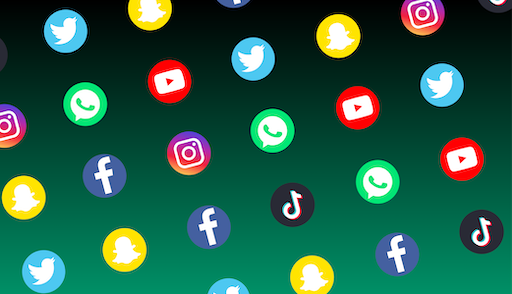1 What is social media, how do I use it?
Figure 2 shows the icons for a selection of social media sites or applications (apps). New social media apps emerge all the time, some of you will use them a lot, others not at all. Each individual is on a different journey in our use of social media. For example, at the time of writing there are already many University students creating content on TikTok accounts about their experiences of studying in HE. However, some people will not even have a TikTok account or have ever used it.
So, let’s start with the basics, by considering what we mean by social media. If an alien from another planet were to ask you ‘What is social media?’ what would you say? Sometimes when we think about how we would reply to this type of question we think about the sites or apps we use as part of our engagement with social media. It is quite likely you would mention one of these sites that can be seen in the image above such as Facebook, Twitter, Instagram etc in your reply. However, these are examples of social media apps rather than a description of what social media actually is.
According to Megan Poore (2016) social media is ‘all forms of digital technology that allow us to communicate and share information or content’ with each other using the internet.”
Social media encompasses everything from Facebook, Twitter and WhatsApp to Wikis and Blogs. It can include completely open activities where your output is available for all to see (e.g. public Twitter account) to those which are limited to a selected group of people (e.g. a WhatsApp group). It allows instantaneous communication, both on a one-to-one and many-to-many basis. This has a number of benefits for students and educators, for example it makes participation easier and facilitates the creation of student driven learning and community spaces. You can also learn valuable lessons about how to communicate appropriately and effectively in these spaces.
However, there is growing evidence that the structure of social media, particularly the hyperlinked nature of content, in which one link directly leads to another, means they can be more distracting than focusing (Andersson et al, 2014). In addition, the multiple functions means that while they are flexible, accessible and easy to use, they can be intrusive or used in ways that mean we are unable to focus or we lose sight of the original goal of our engagement. For example, we can be targeted with advertisements for items the app thinks we might be interested in purchasing, or we could receive distracting messages about an upcoming camping trip in the middle of a workday when we should be writing (which has happened to the Author!).

